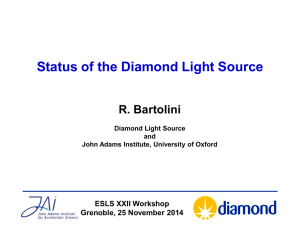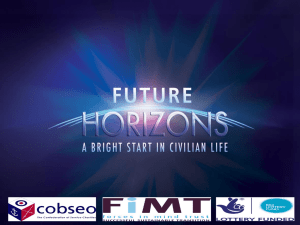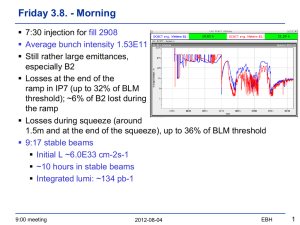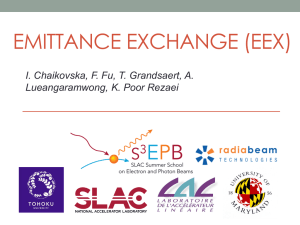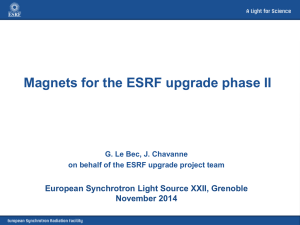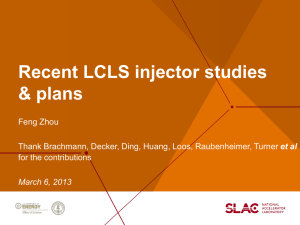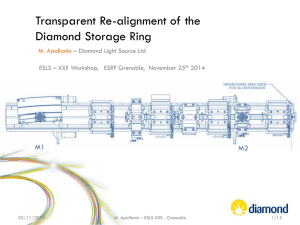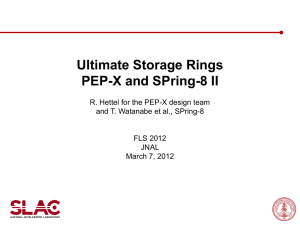Design, status and road map of next generation low emittance rings
advertisement
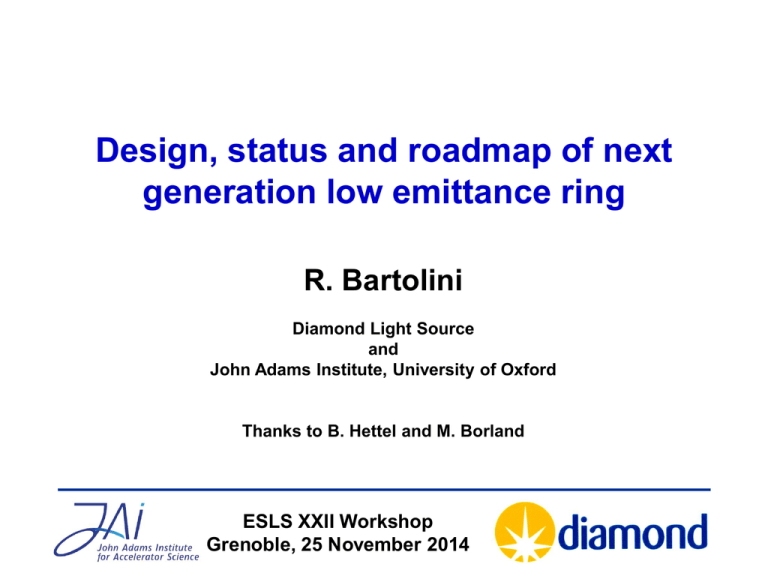
Design, status and roadmap of next generation low emittance ring R. Bartolini Diamond Light Source and John Adams Institute, University of Oxford Thanks to B. Hettel and M. Borland ESLS XXII Workshop Grenoble, 25 November 2014 Outline • Overview of machine upgrade programmes (2010 vs 2014) • Short survey of new ring desing • Challenges in design and technology of ultra low emittance rings • Matching users requests and conclusions ESLS XXII Workshop Grenoble, 25 November 2014 New rings and upgrades R&D programmes (2014) MAX-IV Spring-8 II PEP-X APS USR 330 pm 70 pm (48) 5 pm 100 pm (25) 3 pm 3 GeV 6 GeV 6 GeV 7 GeV 9 GeV 7BA 6BA 7BA 7BA 7BA SIRIUS ESRF II Diamond II ALS BAPS 280 nm 140 pm (28) 140-270 pm (20-10) 100 pm (20) 50 pm 3 GeV 6 GeV 3 GeV 2 GeV 5 GeV TBA USR Beijing 12 7BA-hybrid (270 pm DDBA - 140 pm 5BA) 9BA 10BA SOLEIL SLS ELETTRA ANKA CLS SPEAR III 430 pm (10) 250 pm (20) 250 pm (28) 5000 pm (18) 800 pm (22) 750 pm (13) 2.7 GeV 2.4 GeV 2 GeV 2.5 GeV 2 GeV 3 GeV IPAC13-14 DB-split Longitudinal gradient bend 6BA split-TME 7BA DQBA ESLS XXII Workshop Grenoble, 25 November 2014 IPAC 11-12 Upgrade programmes ~ 2010 Up until ~2010 upgrade of existing third generation light sources targeted e.g .ESRF purple book • Lower vertical emittance (lower coupling) • Longer straight sections (longer IDs or canted Ids) • Higher current (from 200 mA to 300 mA) • Top Up for 16 and 4 bunches modes • New technology: CPMU, RF NC HOM free cavities, SS amplifiers, BPMs. e.g. APS studies • ERL option • other intermediate upgrades options (not precluding the ERL option): • Longer straight sections (longer IDs, customized optics, canted Ids) • Higher current (from 100 mA to 200 mA) • Short pulses programme with crab cavities, • Increase BW of orbit feedback system to achieve sub-m stability up to 200 Hz ESLS XXII Workshop Grenoble, 25 November 2014 Why now ? • Science case is growing: NSLS-II, MAX-IV, APS, Spring-8, ESRF, … science enabled by better photon properties • Growing confidence in “aggressive” low emittance lattice designs from DBA to MBA injection in smaller apertures (…eventually on axis) • Excellent control of the beam properties proven at many light sources orbit, optics, stability, lifetime, losses, customised optics… beam based tuning tools • Key enabling technologies appear to be mature no showstoppers in magnets, vacuum, diagnostics, RF, … ESLS XXII Workshop Grenoble, 25 November 2014 Science case A number of workshop have discussed the science case for ultra low emittance lattices XDL 2011 Workshops for ERLs and DLSRs, Cornell, June 2011 Beijing USR Workshop, Huairou, October 2012 DLSR Workshop, SPring-8, December 2012 DOE BESAC Subcommittee on Future Light Sources, July 2013 SLAC DLSR Workshop, SLAC, December 2013 DLSR Workshop, Argonne, November 2014 A dedicated issue in Journal of Synchrotron Radiation is in publication High brilliance and transversely coherent x-rays - Uniform phase wavefronts: coherent imaging, holography, speckle, etc. - Focusable to smallest spot size: nano-focus - High flux (~1014-1015 photons/sec) in small spot: slits may not be required, etc. - Round beams: H-V symmetric optics, circular zone plates, flexibility in optics ESLS XXII Workshop Grenoble, 25 November 2014 Lattice design Growing confidence in “aggressive” low emittance lattice design • Lattice design evolution from DBA, TBA to 4BA,…MBA: • Lattice optimisation tools improved (linear and nonlinear dynamics) Low emittance lattice require small angle bending 2 x H dipole Jx H(s) D 2 2DD'D' 2 Minimise and D and be close to a waist in the dipole x C q F 2 3 1 N 3d MBA lattices (large rings favoured) ESLS XXII Workshop Grenoble, 25 November 2014 Multiple bend achromats DBA 7BA Dispersion Function 1/2 Insertion Straight 1/2 Insertion Straight Achromat Simplified explanation – Emittance is driven by randomness of photon emission in presence of dispersive (energy-dependent) orbits – electron recoils randomly – Breaking up dipoles and putting focusing (quadrupoles) between the parts allows reducing the amplitude of dispersive orbits – smaller electron recoils ESLS XXII Workshop Grenoble, 25 November 2014 Design challenges Linear optics – To reduce the amplitude of dispersive orbits, must bend more gently (small bending angles) and focus more frequently and more strongly – Finding good optics with existing layout constraints is non trivial Focusing (quadrupole) elements have chromatic aberrations – Sextupole magnets added to correct these – Introduces higher order aberrations that must be corrected – Require magnets with small bore radia Stronger focusing leads to difficult non-linear dynamics – Poor “momentum aperture” reduced lifetime frequent injection – Poor “dynamic aperture” greater difficulty injecting – Some designs are considering on-axis injection Collective instabilities are amplified with short bunches ESLS XXII Workshop Grenoble, 25 November 2014 Optimisation of beam dynamics ESLS XXII Workshop Grenoble, 25 November 2014 Lattice designs MAX–IV (Sweden) is taking the first pioneering step with 7BA, under construction 3 GeV, 528 m, 0.25 nm Sirius (Brazil) just started construction of 5BA with superbend 3 GeV, 518 m, 0.28 nm L. Liu, LNLS. Lattice designs ESRF (France) 6 GeV, 844 m, 4 nm → 150 pm now - ESRF DBA • Dispersion bumps for efficient sextupoles • Longitudinal gradient dipoles (D1, D2, D6, D7) to further reduce emittance • Combined dipole-quadrupoles D3-4-5 • 3-pole wiggler as hard X-ray source APS (US - preliminary) 7 → 6 GeV, 1104 m, 3.1 nm → ~65 pm • ESRF-style lattice, 3-pole wiggler • Swap-out injection • Superconducting undulators SPring-8 (Japan) 8 → 6 GeV, 1436 m, 2.8 nm → <100 pm •lattice under development future - ESRF 7BA Lattice designs ALS-U (US - LBNL) 1.9 GeV, 200 m, 2 nm → 52x52 pm • 9BA • Swap-out injection from accumulator ring • 3-T PM superbend insertions Other rings: •SLS (Switzerland - PSI) 2.4 GeV, 288 m, 5 nm → 0.25 nm •Soleil (France) ALS-II swap-out/accumulator 2.75 GeV, 354 m, 3.9 nm → 0.5 nm ….. ALS-U 24-mm ID chamber ESLS XXII Workshop Grenoble, 25 November 2014 A modified 4BA lattice for Diamond-II • Increase dispersion at chromatic sextupoles • Optimize magnets positions and length leaving more distance between dipoles (no coil clash) • removed sextupoles in the new straight • Longer mid-cell straight section from 3m to 3.4 m – longer is unmanageable ESLS XXII Workshop Grenoble, 25 November 2014 upgrade with Diamond-II (200pm): 300mA and 1%K Brilliance plot using U27 – 72 periods 2 m long with Kmax = 2.02 Tuning curves computed with Spectra 8.0 ESLS XXII Workshop Grenoble, 25 November 2014 Survey of low emittance lattices ESLS XXII Workshop Grenoble, 25 November 2014 Experimental control of the beam optics Growing confidence in the experimental control of the electron optics Proven correction strategies beam based tuning techniques (better instrumentation: diagnostics, power supplies, …) e.g. Diamond operates with a very good control of the beam optics • Optics deviation (beta-beating) redecue to 1% level • Emittance [2.78 - 2.74] (2.75) nm • Energy spread [1.1e-3 - 1.0-e3] (1.0e-3) • Emittance coupling ~0.08% achieved → vertical emittance ~ 2.0 pm (2009 WR) 6 m rms vertical Records for smallest vertical emittance (2011-2014) SLS 0.9 pm Courtesy L. Rivkin PSI and EPFL APS 0.35 pm ESLS XXII Workshop Grenoble, 25 November 2014 Comparison machine/model and Lowest vertical emittance (back in 2011) Model emittance Measured emittance -beating (rms) Coupling* (y/ x) Vertical emittance ALS 6.7 nm 6.7 nm 0.5 % 0.1% 4-7 pm ASP 10 nm 10 nm 1% 0.01% 1-2 pm 2.74 nm 2.7-2.8 nm 0.4 % 0.08% 2.0 pm 4 nm 4 nm 1% 0.1% 3.7 pm SLS 5.6 nm 5.4-7 nm 4.5% H; 1.3% V 0.04% 2.0 pm SOLEIL 3.73 nm 3.70-3.75 nm 0.3 % 0.1% 4 pm SPEAR3 9.8 nm 9.8 nm < 1% 0.05% 5 pm SSRF 3.9 nm 3.8-4.0 nm <1% 0.13% 5 pm Diamond ESRF Since these early studies * best achieved 2011 SLS reached 0.9 pm V emittance Diamond is providing 8 pm V emittance in users’ operation ESRF is providing 8 pm V (and lower) emittance in users’ operation Enabling technology Compact magnet and vacuum technology • Precision magnet pole machining for small aperture magnets, combined function magnets, tolerance for magnet crosstalk (e.g. MAX-Lab) • NEG-coated vacuum chambers enable small apertures to enable high magnet gradients Pioneered at CERN, used extensively at Soleil, and adopted for MAX-IV and Sirius MBA lattices MAX-IV Courtesy S. Leemans heater tape for in-situ NEG Diamond, 11 July 2014 bake-out Sirius SPring-8 concept K. Soutome Enabling technology Other advances in accelerator and light source technology: • Fast kickers for on-axis injection Fast kickers (KEK ATF) • Sub-micron e- BPMs with micron resolution single pass capability: non-linear lattice tuning Higher order resonances detected by turn-turn BPMs • Accelerator and beam line component mechanical positioning and stabilizing systems (A. Franchi) • “In-situ” and beam-based magnet measurement and alignment methods • Mode-damped RF cavities (fundamental and harmonic) • Highly stable solid state RF power sources • High performance IDs (superconducting, Delta, RF, etc.) • Advances in X-ray optics and detectors start-to-end beam line system simulations, SC detectors, cryo-cooled mirrors, etc. SPring-8 concept based on NSLS-II vibrating wire method - K. Soutome Delta undulator prototype - A. Temnykh SC undulator development at LBNL (S. Prestemon et al.), APS (E. Gluskin et al.) and elsewhere Conclusions Many 3GLS operates since 2000’s with nominal parameters • few nm H emittance • 300-500 mA • 8pm V emittance However: – 2010 Petra-III was commissioned 1 nm H emittance – 2011-12 SLS and ASP ~1 pm V emittance (best achieved) – 2012 ESRF et al. operate with 8pm V emittance – 2013 ALS upgraded to a 2 nm H emittance lattice – 2014 NSLS-II started operation 0.5 nm H emittance – 2014 Petra III has tested a 160 pm lattice at 3GeV – 2016 MAX IV 300 pm H emittance lattice – 2019 ESRF II 140 pm H emittance lattice ESLS XXII Workshop Grenoble, 25 November 2014 Conclusions Man 3GLS are investigating a full ring upgrade (Diamond–II, SLS-II, SOLEIL, …) Various MBA options are under analysis. Some of the designs have still lots of flexibility in the technical choices Need input from PBSs and Users what emittance? are round beams needed? alternate high beta – low beta ? operating modes (e.g. low alpha, …)? … open for any exotic ideas? AP should explore tailoring the design to their specific beamlines ESLS XXII Workshop Grenoble, 25 November 2014 Low emittance ring community The development of ultra low emittance rings is now seriously tackled by a large community, including damping rings and HEP colliders meeting regularly in workshop discussing general or dedicated topics (beam dynamics, collective effects, technology for low emittance rings • ICFA Low Emittance Rings Workshops (LowERing) • XDL 2011 Workshops for ERLs and DLSRs, Cornell, June 2011 • Beijing USR Workshop, Huairou, October 2012 • DLSR Workshop, SPring-8, December 2012 • Low Emittance Ring Workshop, Oxford, July 2013 • SLAC DLSR Workshop, SLAC, December 2013 • Workshop on Low Emittance Rings Technology (ALERT 2014), Valencia, 2014 • Low Emittance Rings Workshop (LER2014), Frascati, September 2014 • DLSR Workshop, Argonne, November 2014 ESLS XXII Workshop Grenoble, 25 November 2014
